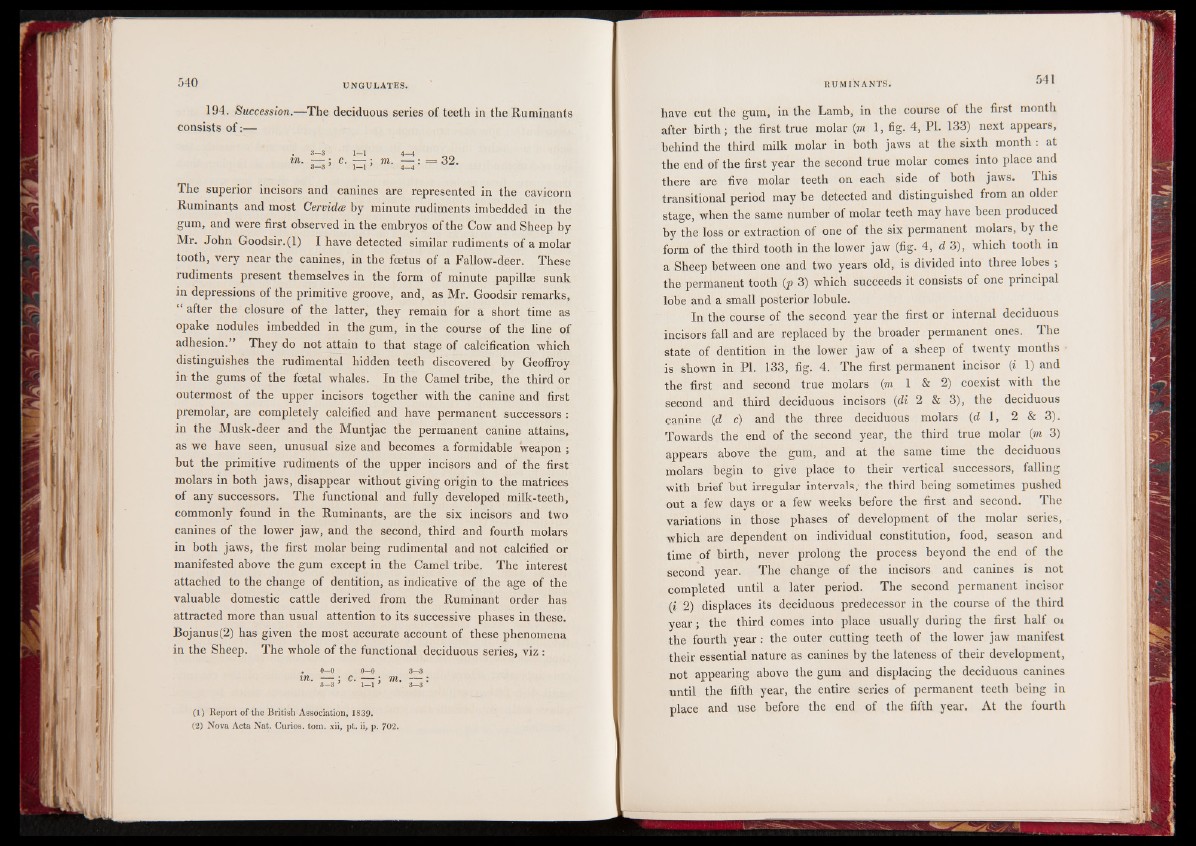
194. Succession.—The deciduous series of teeth in the Ruminants
consists of:—
in. 3—3
3—3 ’ m. 4 -4
4—4 ' = 32.
The superior incisors and canines are represented in the cavicorn
Ruminants and most Cervidoe by minute rudiments imbedded in the
gum, and were first observed in the embryos of the Cow and Sheep by
Mr. John Goodsir.(l) I have detected similar rudiments of a molar
tooth, very near the canines, in the foetus of a Fallow-deer. These
rudiments present themselves in the form of minute papillæ sunk
in depressions of the primitive groove, and, as Mr. Goodsir remarks,
“ after the closure of the latter, they remain for a short time as
opake nodules imbedded in the gum, in the course of the line of
adhesion.” They do not attain to that stage of calcification which
distinguishes the rudimental hidden teeth discovered by Geoffroy
in the gums of the foetal whales. In the Camel tribe, the third or
outermost of the upper incisors together with the canine and first
premolar, are completely calcified and have permanent successors :
in the Musk-deer and the Muntjac the permanent canine attains,
as we have seen, unusual size and becomes a formidable weapon ;
but the primitive rudiments of the upper incisors and of the first
molars in both jaws, disappear without giving origin to the matrices
of any successors. The functional and fully developed milk-teeth,
commonly found in the Ruminants, are the six incisors and two
canines of the lower jaw, and the second, third and fourth molars
in both jaws, the first molar being rudimental and not calcified or
manifested above the gum except in the Camel tribe. The interest
attached to the change of dentition, as indicative of the age of the
valuable domestic cattle derived from the Ruminant order has
attracted more than usual attention to its successive phases in these.
Bojanus(2) has given the most accurate account of these phenomena
in the Sheep. The whole of the functional deciduous series, viz :
. 0—0 0—0 3—3
(1) Report of the British Association, 1839.
(2) Nova Acta Nat. Curios, tom. xii, pt. ii, p. 702.
have cut the gum, in the Lamh, in the course of the first month
after birth; the first true molar (m 1, fig. 4, PI. 133) next appears,
behind the third milk molar in both jaws at the sixth month : at
the end of the first year the second true molar comes into place and
there are five molar teeth on each side of both jaws. This
transitional period may be detected and distinguished from an older
stage, when the same number of molar teeth may have been produced
by the loss or extraction of one of the six permanent molars, by the
form of the third tooth in the lower jaw (fig. 4, d 3), which tooth in
a Sheep between one and two years old, is divided into three lobes ;
the permanent tooth (p 3) which succeeds it consists of one principal
lobe and a small posterior lobule.
In the course of the second year the first or internal deciduous
incisors fall and are replaced by the broader permanent ones. The
state of dentition in the lower jaw of a sheep of twenty months •
is shown in PI. 133, fig. 4. The first permanent incisor (i 1) and
the first and second true molars (m 1 & 2) coexist with the
second and third deciduous incisors (di 2 & 3), the deciduous
canine (d c) and the three deciduous molars {d 1, 2 & 3).
Towards the end of the second year, the third true molar (m 3)
appears above the gum, and at the same time the deciduous
molars begin to give place to their vertical successors, falling
with brief but irregular intervals,’ the third being sometimes pushed
out a few days or a few weeks before the first and second. The
variations in those phases of development of the molar series,
which are dependent on individual constitution, food, season and
time of birth, never prolong the process beyond the end of the
second year. The change of the incisors and canines is not
completed until a later period. The second permanent incisor
(i 2) displaces its deciduous predecessor in the course of the third
year; the third comes into place usually during the first half oi
the fourth year: the outer cutting teeth of the lower jaw manifest
their essential nature as canines by the lateness of their development,
not appearing above the gum and displacing the deciduous canines
until the fifth year, the entire series of permanent teeth being in
place and use before the end of the fifth year. At the fourth